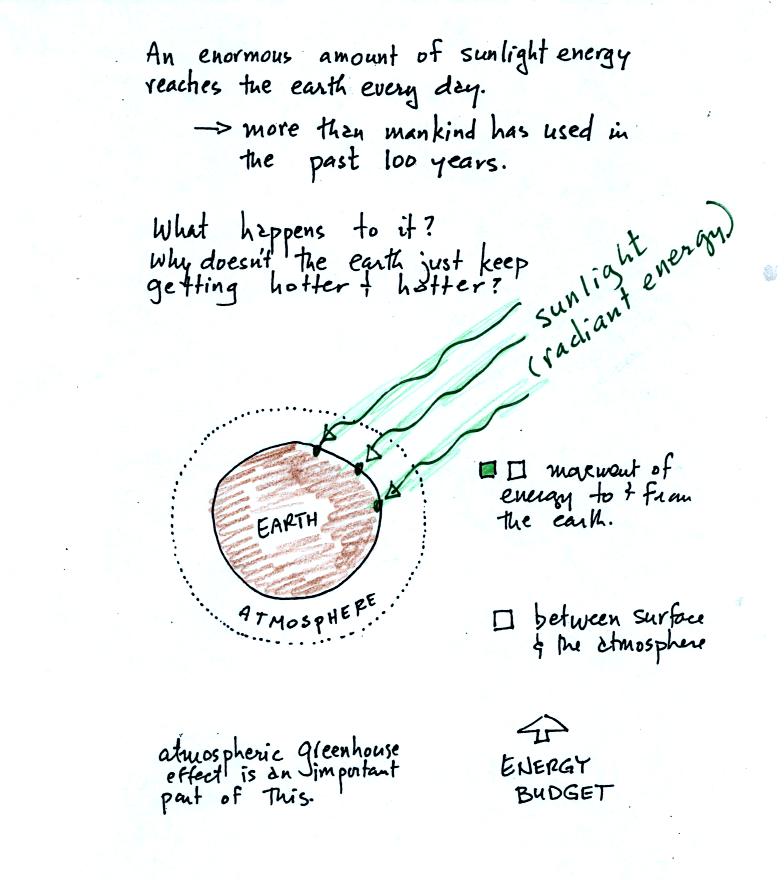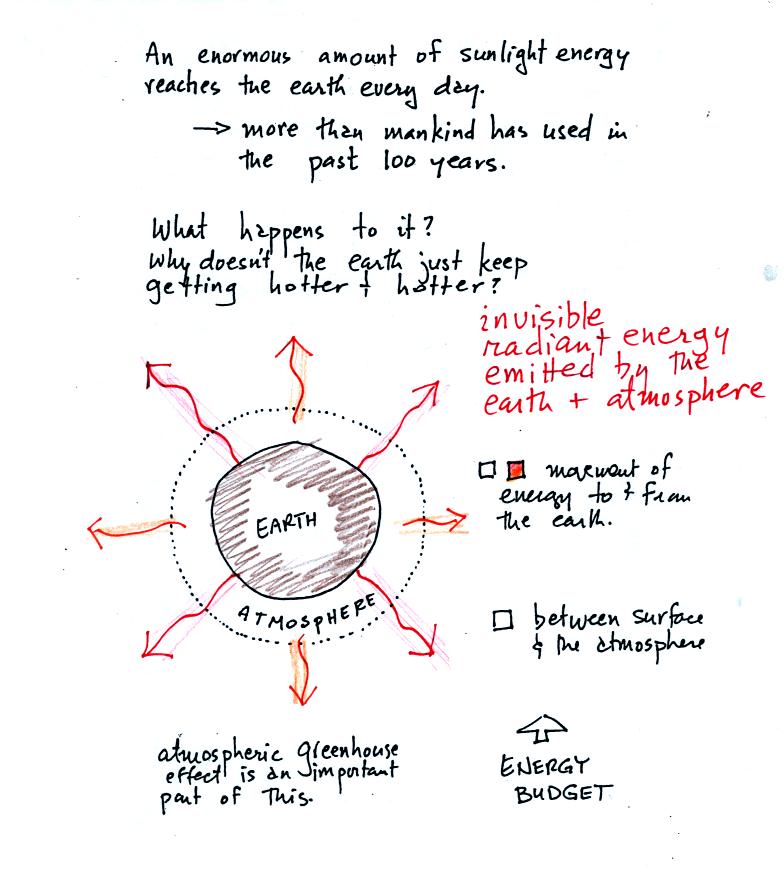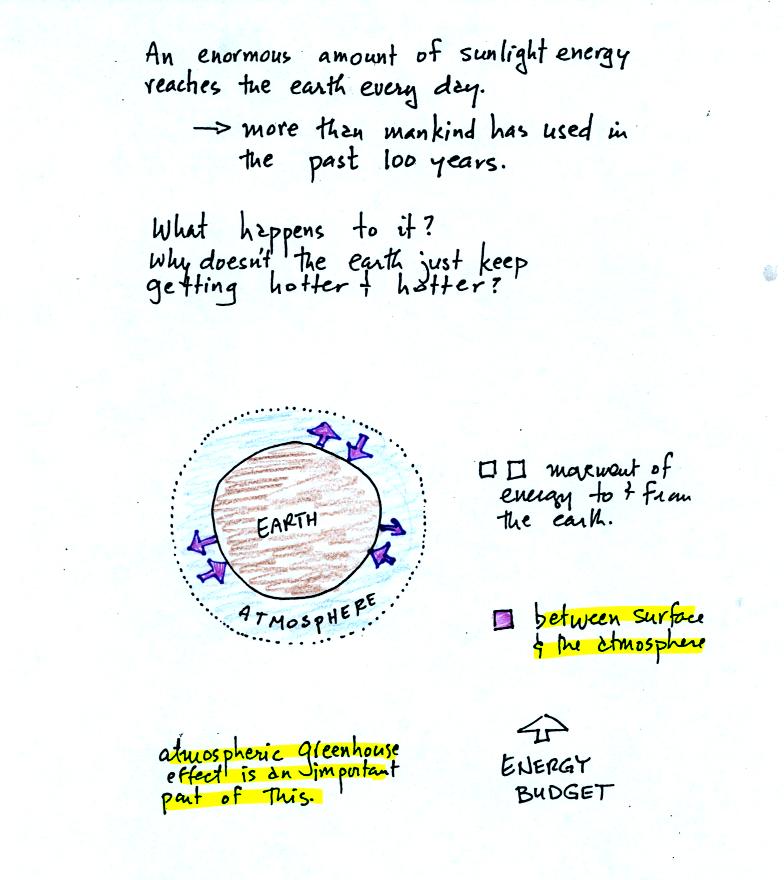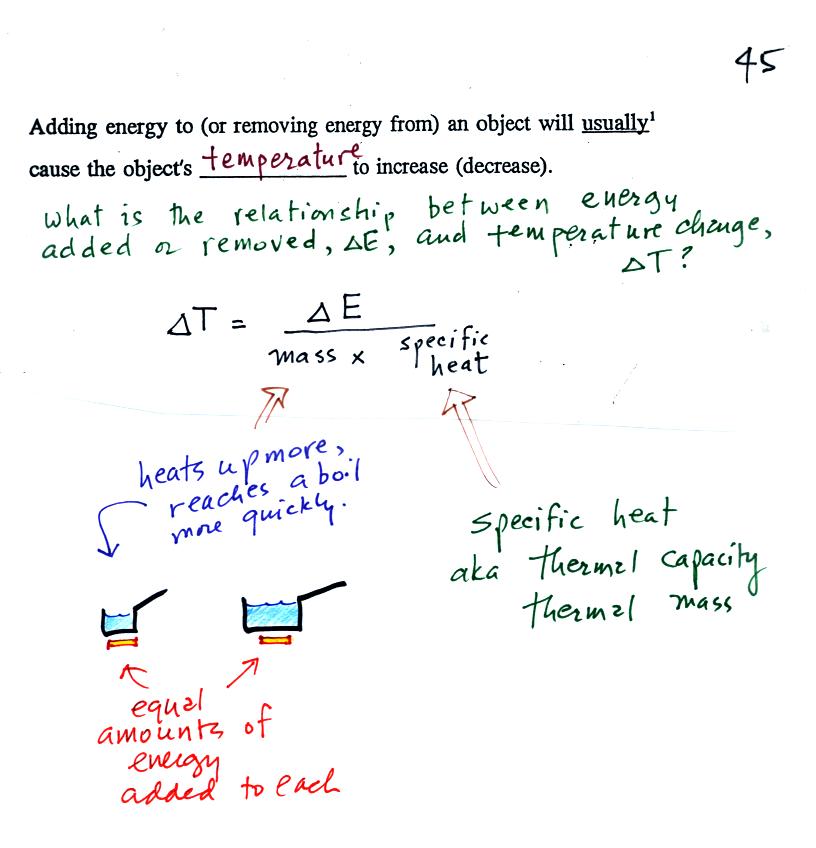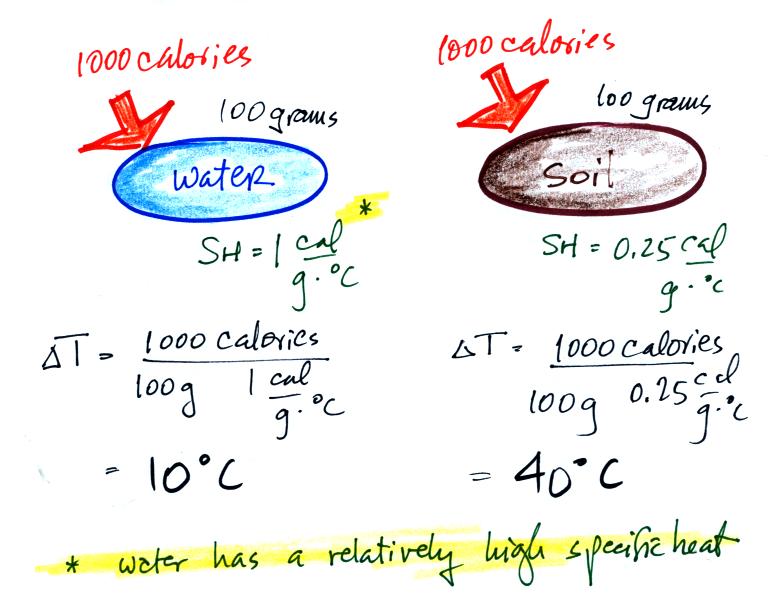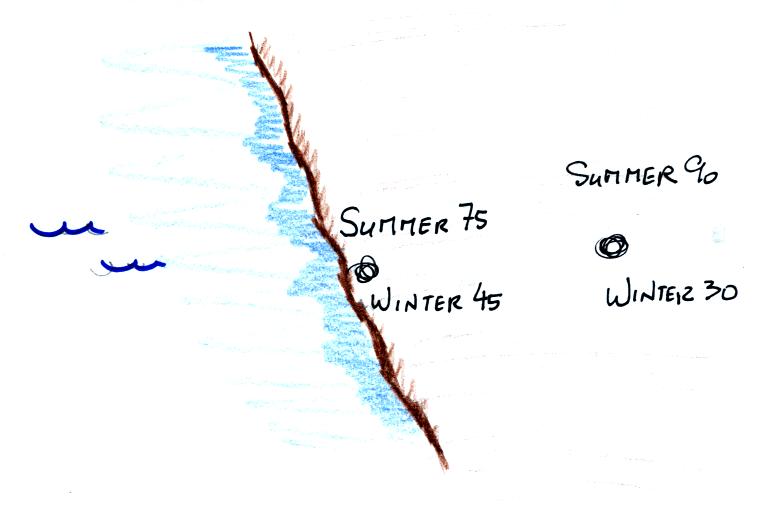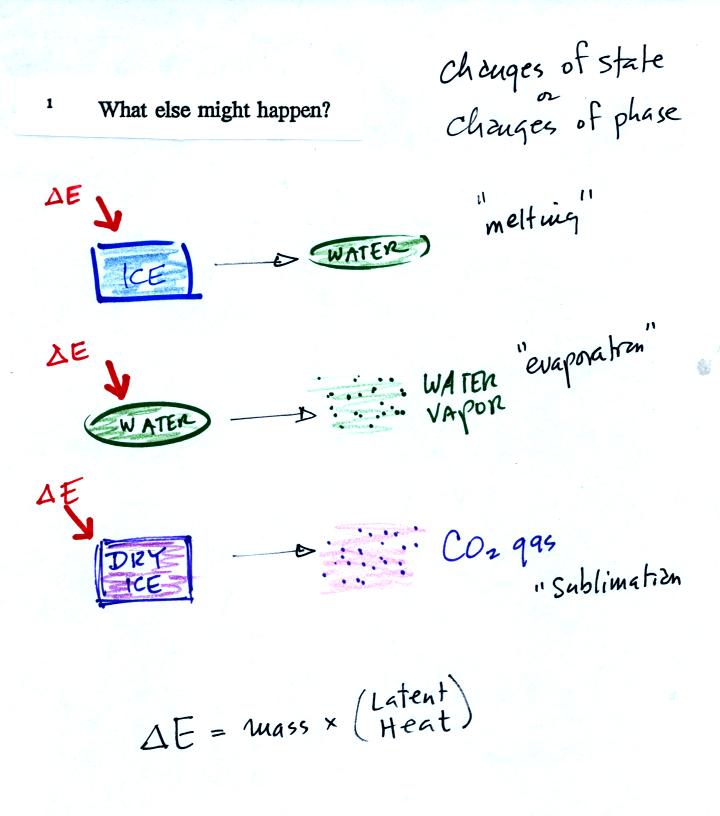Friday Feb. 18, 2011
click here to
download today's notes in a more printer friendly format
A fairly long, 13 minute, selection of music from Iron and Wine ("Belated Promise Ring",
"House by the Sea",
and
"Jezebel")
while I handed out quizzes.
Quiz #1 has been graded and was returned in class. Please
carefully check the grading and make sure the points missed are added
up correctly. Be sure to hang onto graded work as it is returned
to you. Don't throw away anything until after you've received a
grade at the end of the semester.
Today's picture of the day
Tomato seedlings (the small
guys in back are peppers) growing on the warm sunny window sill in my
office. This will come up during the course of today's class.
During the next couple of weeks we
will be concerned with energy,
temperature, heat, energy transport, and
energy
balance between the earth, atmosphere, and space.
It is easy to
lose sight of the main concepts because there are so many
details. The following (found on pps 43&44 in the photocopied
Class Notes) is meant to introduce some of what we will be covering in
class. (some of the figures that follow are from a previous
semester and
may differ somewhat from what we did in class)

Types
of
energy
We will learn the names of several different types or forms of
energy. Kinetic energy is energy of motion. Some examples (both large
and microscopic scale) are mentioned
and sketched above. This is a relatively easy to visualize and
understand form of energy.
Latent heat energy is perhaps the most underappreciated and most
confusing type of energy. The word latent refers to energy that is
hidden in water and water vapor. The hidden energy emerges when
water vapor condenses or water freezes (the energy had been added
earlier when ice was melted or water was evaporated).
Radiant energy is a very important form of energy that was for
some
reason left off the original list. Sunlight is an example of
radiant energy that we can see and feel (you feel warm when you stand
in sunlight). There are many types of radiant energy
that are invisible. Electromagnetic radiation is another name for
radiant energy.
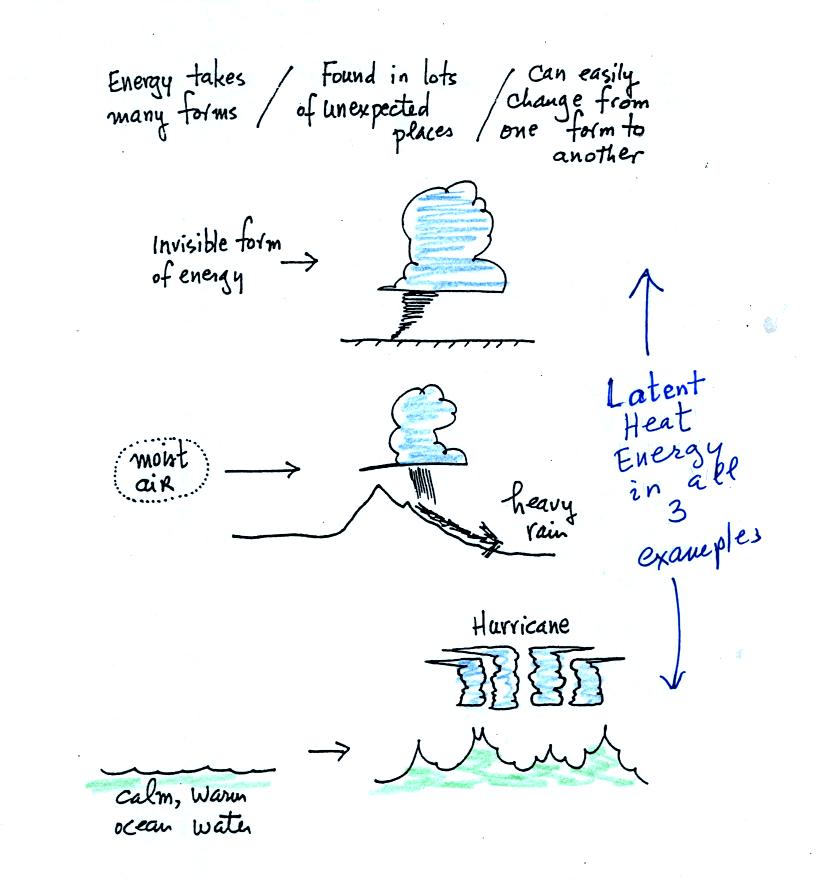
Water vapor is effectively a particularly important form of
invisible
energy.
When water vapor condenses to produce the water droplets (or ice
crystals) in a
cloud, an enormous amount of latent heat energy is released into the
atmosphere.
It is hard to visualize or appreciate the amount of energy
released
into the
atmosphere during condensation. You can imagine the work that you
would need to do to carry a gallon of water
(8 pounds) from Tucson to the top of Mt. Lemmon. To
accomplish
the same thing Mother Nature must first evaporate the water and (if my
calculations are correct) that requires about 100 times the energy that
you would use to carry the 8 pounds of water to the summit of Mt.
Lemmon. And Mother Nature transports a lot more than just a
single gallon.
Energy transport
Four energy transport
processes are listed below.
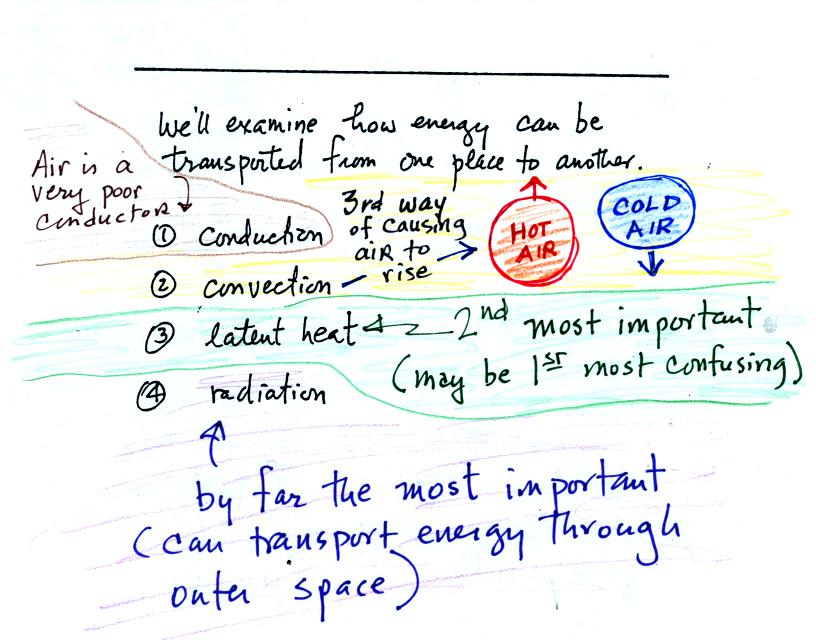
By far the
most important process is energy transport in the form of
electromagnetic radiation (sunlight is a common
form of electromagnetic radiation). This is the
only process that can transport energy through empty space.
Electromagnetic radiation travels both to the earth (from the sun) and
away from the earth back into space. Electromagnetic radiation is
also
responsible for about 80% of the
energy transported between the ground and atmosphere.
You might be
surprised to learn that latent heat is the second most important
transport process.
Rising parcels of warm air and sinking parcels of cold air are
examples of free convection. Because of convection you feel
colder or
a cold windy day than on a cold calm day.
Ocean currents are also an example of convection. Ocean currents
transport energy from the warm tropics to colder polar regions. Not all of these
details were mentioned in class.
Remember that convection is one of the ways of causing rising air
motions in the atmosphere (convergence
into centers of low pressure, fronts, and orographic or topographic
lifting were the other ways).
Conduction is the least important energy transport at least in the
atmosphere. Air is such a poor conductor of energy that it is
generally considered to be an insulator.
Energy
balance
and the
atmospheric greenhouse effect
The next picture (the figure drawn in class has been split into three
parts for improved clarity) shows energy being transported from the sun
to
the earth in the form of electromagnetic radiation.
We are aware of this energy because
we can see it (sunlight
also contains invisible forms of light) and feel it. With all of
this energy arriving at and
being
absorbed by the earth, what keeps the earth from getting hotter and
hotter? The answer is that the earth also sends energy back into
space (the orange and pink arrows in the figure below)
This infrared light is an
invisible form of energy (it is weak enough that we
don't usually feel it either). A balance
between incoming and outgoing energy is achieved and the earth's annual
average temperature remains constant.
We will also look closely at energy transport between the earth's
surface and the atmosphere. This is where latent heat energy transport,
convection and conduction operate (they can't transport energy beyond
the atmosphere and into outer space).
That is also where the atmospheric
greenhouse functions. That will be a important goal -
to
better understand how the atmospheric greenhouse effect works.
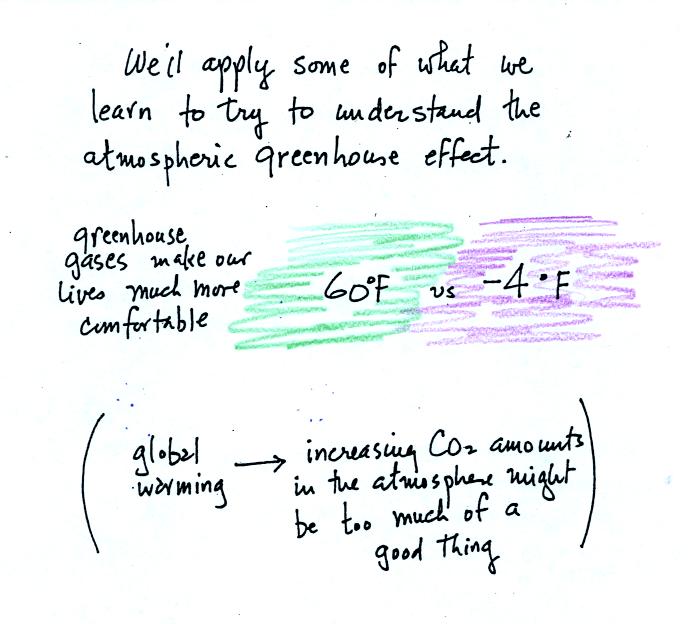
The greenhouse effect is getting a
lot of "bad press". If the earth's atmosphere didn't contain
greenhouse gases and if there weren't a greenhouse effect, the global
annual average surface temperature would be about 0 F (scratch out -4 F
and put 0 F, it's easier to remember). Greenhouse gases raise
this
average to about 60 F and make the earth a much more habitable
place. This is the beneficial aspect of the
greenhouse effect.
The detrimental side is that atmospheric greenhouse gas concentrations
are increasing. This might enhance the greenhouse effect and
cause the earth to warm. While that doesn't necessarily sound bad
it could have many unpleasant side effects. That's a subject
we'll explore briefly later in the semester.
When you
add energy to an object, the object will usually
warm
up (conversely when you take energy from an object the object will
cool). It is relatively easy to come up with an equation that
allows
you to figure out what the temperature change will be (one of those
equations I'll probably write on the board during the next quiz - try
to understand it, you don't have to memorize it).
The temperature change will
first depend on
how much energy was added. This is a direct proportionality, so
delta E is in the numerator of the
equation (delta E and delta T are both positive when energy is added,
negative when energy is taken from something)
When you add equal amounts of energy to large and small pans
of water, the small pan will heat up more
quickly. The temperature change, delta T, will depend on the
amount of water, the mass. A small mass will mean a large delta
T, so mass should go
in the denominator of the equation.
Different materials
react differently when energy is added to them. A material with a
large specific heat will warm more slowly than a material with a small
specific heat. Specific heat has the same kind of effect on delta
T as
mass. Specific heat is sometimes called "thermal mass" or
"thermal capacity." You can think of specific heat as
being thermal inertia - a substance with high specific heat, lots of
thermal inertia, will be reluctant to change temperature.
Here's an important example that will show the effect of specific
heat (middle of p. 45)
Equal
amounts of energy (1000 calories, note that calories are units of
energy) are added to
equal masses (100 grams) of water and soil. We use water and soil
in the
example because most of the earth's surface is either ocean or land.
Water has a higher specific heat than soil, it only warms up 10o
C.
The soil has a lower specific heat and warms up 40o C, 4
times more
than the water (there is a factor of 4 difference in the specific heats
of water and soil).
These different rates of warming of water and soil have
important effects on regional climate.
Oceans moderate the climate.
Cities near a large body
of water won't warm as much in the summer and won't cool as much during
the winter compared to a city that is surrounded by land.
The yearly high and low monthly average temperatures are shown at
two locations above. The city on the
coast has a 30o F annual range of temperature (range is the
difference between the summer and winter temperatures). The
city further
inland (assumed to be at the same latitude and altitude) has an annual
range of 60o F. Note that both cities have the same 60o
F annual
average temperature. We'll see a much more dramatic example of
the moderating effect of water on climate in a couple of weeks.
Here's another situation where you
can take advantage of water's
high specific heat to moderate "micro climate."
Here are some tomatoes being
planted in early February in my
vegetable garden a winter or two ago. It still gets
plenty cold enough at night to kill tomatoes (the brocolli
and lettuce in the background can handle a
light frost) so you have to protect the tomatoes.
Here's one way of doing that.
You
can
surround
each
plant
with a "wall of water" - a tent
like arrangement that surrounds each plant. The cylinders are
filled with water and they take advantage of
the high specific
heat of water and won't cool as much as the air or soil would during a
cold
night.
Adding
energy to an object will usually cause it to warm. But there
is another possibility (bottom p. 45), the object could change
phase (change
from solid to liquid or
gas). Adding energy to ice might cause
the
ice to melt. Adding energy to water could cause it to
evaporate. The figure below is
a little more detailed version of what was drawn in class.
The equation at the bottom of the
figure above allows you to
calculate how much energy is required to melt ice or evaporate water or
sublimate dry ice. You multiply the mass by the latent heat, a
variable that depends on the particular material that is changing
phase.
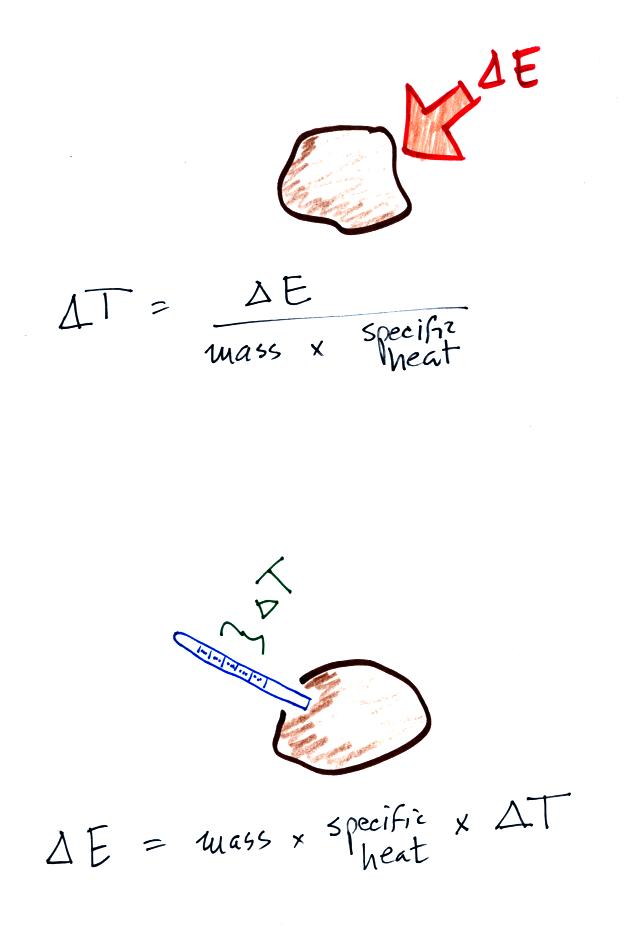
If you add energy to or remove
energy from an object, the
object
will usually change temperature. You can calculate the
temperature change if you know the object's mass and its specific
heat. That's the equation we used in the example calculation
above.
We will be using the equation next in a slightly different way in
a
class
experiment/demonstration. We will measure the temperature change of a
small cup of water and
use that to
determine the amount of energy lost by the water.
A couple of students from the class were nice enough to volunteer
to
perform the experiment.
The object of the experiment was to
measure the latent heat of
vaporization of liquid nitrogen. That just means measuring the
amount of energy needed to evaporate a gram of liquid nitrogen.
The students that are doing Experiment #2 are measuring the latent heat
of fusion of ice, the energy needed to melt one gram of ice.
You'll
find the following figure on p. 45a in the photocopied
Classnotes.
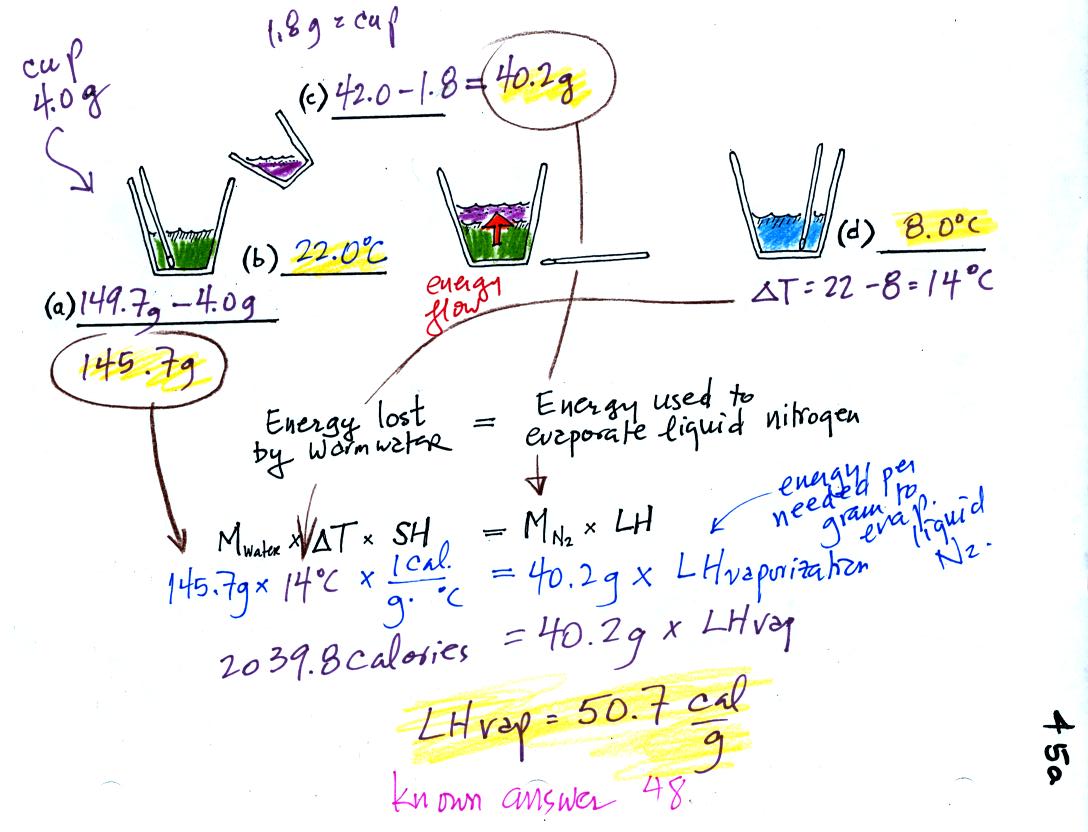
(a)
Some room temperature water poured into a styrofoam cup weighed
149.7
g. The cup itself weighed 4.0 g, so we had 145.7 g of water.
(b)
The water's temperature was 22.0 C (room temperature).
(c)
40.2 g of liquid nitrogen was poured into the cup of water.
It takes energy to turn liquid nitrogen into nitrogen gas.
The needed energy came from the water. This flow of energy is
shown in the middle figure above. Because the
experiment is performed in a styrofoam cup we assume that there is no
energy
flowing between the water in the cup and the surounding air. All
of the energy leaving the water is being used to evaporate nitrogen
(d)
After the liquid nitrogen had evaporated the water's
temperature was remeasured. It had dropped to 8.0 C. That
is a
temperature drop of 22.0 - 8.0 = 14.0 C.
Because we knew how
much water we started with, its temperature drop, and water's specific
heat we can calculate how much
energy was taken from the water.
145.7 g x 14 C x 1 cal/(g C) = 2039.8 calories
We then divide that number by the amount of liquid nitrogen that
was
evaporated.
2039.8calories / 40.2 g = 50.7
calories per gram
A
responsible & trustworthy student (though not a Buddhist monk) in
the class informed us that
the known value is 48 cal/g, so this measurement
was really close to the known value.
For their courage the two students that did the experiment
(and also the student that read out the results) received
green cards.



